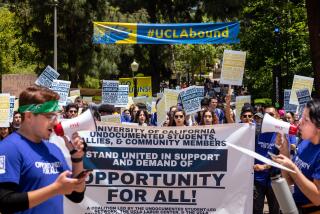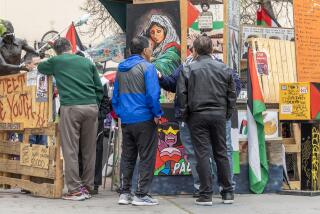Central American Students Hope to Explore Their Roots
There were times when Siris Barrios, now a 20-year-old urban planning major at Cal State Northridge, wouldn’t even admit she was born in El Salvador.
Her parents rarely discussed the civil war or their trek to the United States. At the public schools near her Watts home, her Mexican American peers looked down on her, she said, recalling a Spanish-language vulgarity she would hear directed toward Salvadorans.
So when she started applying for college, she looked for a place where she could learn about her origins, and perhaps even take pride in them.
“None of the places I looked had a Central American Studies department,” she said. “But CSUN had CAUSA.”
The Central American United Students Assn. was formed in 1990 with the mission of attracting more Central American students to Cal State Northridge and promoting the study of their culture.
More than 1,200 students of Central American descent attended Cal State Northridge this year, more than at any other university, according to Northridge officials. And last week, the university that established the first Pan African studies and Chicano studies departments created the nation’s first Central American studies minor.
The new program will focus on the half a million Guatemalans, Salvadorans, Nicaraguans and other Central American immigrants in Southern California, a number projected to reach 2.5 million by 2010.
According to U.S. Census figures, California is home to most of the nation’s Central American immigrants, who represent about 5% of the U.S. Latino population.
Cal State Northridge professors say the San Fernando Valley has become a major destination for many Central Americans. As the Valley’s only large four-year university, Cal State Northridge is the logical choice for many Central American immigrants, said Gregory Velazco y Trianosky, associate dean for humanities and the Central American student association’s advisor.
And they are having an impact on the university, he said.
“These kids have been through everything,” he said. “They have been through more than most adults in the U.S. will ever go through. And they have learned a lot about political organizing.
“Most of them are not radicals, but they do have the skills that come from political organizing in Central America.”
Monica Novoa, 20, has been with the Central American United Students Assn. for three years and helped push for the new program. Her family left El Salvador in 1982, when federal troops were targeting teachers and other intellectuals for intimidation and slaughter. Novoa said her father was a teacher and a leftist. When she was 3, coyotes--or guides for undocumented immigrants--took the family through Guatemala, Mexico and a torn border fence into California.
Once he arrived in the United States, her father went to school to become an electrician. Her mother got into the real estate business. But like Barrios’ parents, Novoa’s family rarely discussed their experiences in El Salvador.
“Most of what I knew about El Salvador was from the popular music that I listened to,” she said. “One of my favorite lines is from a Victor Jara song where he’s saying: ‘If the hands that work the soil are the people’s, then why doesn’t the harvest belong to those who work the land?’ ”
In high school, she said she found more acceptance among African American students than Mexican American students.
“They were nationalistic,” she said. “They would be all about ‘brown pride,’ and all that. They would want me to admit that El Salvador was a part of Mexico or that their country was better. Or they would tell us that we were dirty.”
Velazco y Trianosky said that Central Americans get singled out because they are settling in communities alongside more established immigrant groups.
“They’re the new kid on the block,” said Velazco y Trianosky. “The newest immigrants always get dumped on. And they didn’t come here just as new immigrants--they came here destitute, as refugees. They started at ground zero.”
Over the last 20 years, hundreds of thousands of Central Americans fled poverty, civil war and death squads in Central America.
If Central American students have had to deal with Mexican American prejudice in the Los Angeles Unified School District, they say it is relatively rare at Cal State Northridge, where the Chicano studies department has tried to foster a feeling of Latino unity.
The idea of a Central American studies program was proposed in 1993 to then-Provost Louanne Kennedy. But after the 1994 Northridge earthquake devastated the campus, Kennedy, the university’s interim president, shelved the proposal.
In 1997, the student members of the association, with the support of the Chicano studies department, renewed their push for the program. Kennedy gave them permission to plan classes within the department with the goal of eventually creating a minor degree in Central American studies.
So far there are 12 courses, with 10 more being planned. The university also is planning to hire two more professors by the fall, bringing the number of teachers devoted to the program to five.
Lecturer Roberto Lovato, coordinator of the Central American studies program, has been teaching a course called “The Salvadoran Experience” and has presided over some spirited discussions.
“I’ve had kids try to defend the use of death squads to enforce stability,” he said. Last semester, Lovato asked his class to pretend they were Central American coffee growers.
You have stolen the land from the peasants, he told them. You’re making money hand over fist and you have the national guard at your disposal, but the indigenous people, the landless, are angry. What do you do?
“Most students said they would give back the land, or at least some of it,” he said. “But I also had students say: ‘Business is business.’ I love teaching these students--the Central American mind is an ideological minefield.”
That’s because the Central American immigrants who fill his classes come from all economic strata and political points of view. Often students who would have been in different social classes in Central America--and would have never crossed paths--sit in the same classroom at Cal State Northridge and debate, Lovato said.
Novoa, who is a year away from an English degree, said she is getting more than an education from classes like “The Salvadoran Experience.”
“It’s helping me build my identity as a Salvadoran American,” she said.
More to Read
Sign up for Essential California
The most important California stories and recommendations in your inbox every morning.
You may occasionally receive promotional content from the Los Angeles Times.










